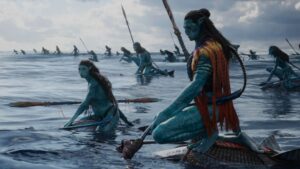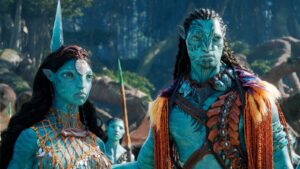Avatar: The Way of Water
- -Set more than a decade after the events of the first film, learn the story of the Sully family (Jake, Neytiri, and their kids), the trouble that follows them, the lengths they go to keep each other safe, the battles they fight to stay alive, and the tragedies they endure.
Photos
Storyline
Details
Box Office
Company Credits
Technical Specs
James Cameron Thinks Like A Bollywood Family Drama, With Ten Brains and A Heart
Even if it appears dramatic, James Cameron wants his emotions to be at the center. We only need filmmakers, no apology needed.
What’s Good: Despite his wealth and resources, Cameron isn’t obsessed with completely changing the world; instead, he’s committed to sharing the tales of the characters he’s created.
What’s Bad: He enters a zone where you practically feel like you’re in a stroller and James is your guide around this world. It’s also rather nice, however in certain areas it simplifies a lot.
Jake Sully is clearly a Na’vi (people of Pandora) and is no longer a human piloting an avatar. Not only is he the Olo’yekton, but he is also the Toruk Makto, and it is his duty to lead the entire forest-dwelling and worshipping society. One day, the sky people reappear, and Jake must overcome the old foe disguised in a new persona in order to preserve his family. Yes, as you will discover, he is currently the father of four—actually, five—children.
Plot:
Jake Sully, the chief of the Omatikaya clan, and Neytiri are responsible for raising their family, which consists of two sons, Neteyam and Lo’ak, his daughter Tuk, and an adopted daughter named Kiri, who was born from Grace Augustine’s inert avatar, sixteen years after the Na’vi drove the Resources Development Administration (RDA) out of Pandora. Raised by human scientists who stayed on Pandora, Spider is the son of the late Colonel Miles Quaritch and often pays them visits. Frances Ardmore, the RDA’s new leader, returns to settle Pandora. Recombinants, Na’vi avatars implanted with the memories of fallen human warriors, are among the new members of the RDA; Quaritch’s Recombinant leads them.

Jake spearheads a guerilla battle against the RDA a year later. Quaritch and his henchmen kidnaps Jake’s kids during a counterinsurgency operation. When Jake and Neytiri show up, they manage to let them free, but Spider is captured by Quaritch, who then identifies him as his son. Quaritch makes the decision to spend time with Spider in an attempt to win his favor after the RDA questions him ineffectively for more information. Spider imparts knowledge of Na’vi language and culture to Quaritch in exchange.
Sensing that Spider’s information could be dangerous, Jake and his family leave the Omatikaya and move to the eastern sea of Pandora, where the Metkayina clan lives. There, the family blends in with the Metkayina: Lo’ak makes friends with Tsireya, their daughter, while Kiri forges a spiritual connection with the sea and Jake and Neytiri help Chief Tonowari and his wife Ronal. After Tonowari’s and Jake’s sons got into a fight because the former made fun of Kiri, Lo’ak apologizes at Jake’s request because he started the incident. Then Tonorwari’s eldest son Aonung and his pals lure Lo’ak on a hunting expedition, leaving him stranded in the domain of a sea predator.

Payakan, a Tulkun—an intelligent and peaceful whale-like animal that the Metkayina regard as spiritual brethren—saves Lo’ak from the predator, and the two become friends. When Lo’ak returns, he is informed that Payakan is an outcast but gains Aonung’s friendship by taking responsibility for the trip. Later, Kiri connects to the Spirit Tree located underwater in the Metkayina and sees Grace in a vision. However, the link-induced trance causes Kiri to have a seizure, almost drowning her. Jake calls in Max Patel and Norm Spellman to assist, diagnosing Kiri with epilepsy and cautioning her not to connect to the Spirit Tree ever again.
After some time, Ronal tends to Kiri’s wounds, and Quaritch finds the plane that carried Norm and Max to the Metkayni archipelago. Along with Spider, Quaritch teams up with Captain Mick Scoresby of the RDA’s maritime operations to commandeer a whaling vessel that is searching for Tulkuns. Despite questioning several tribes, Quaritch’s soldiers fail to locate Jake as they start assaulting the archipelago. To get Jake to come out, he intends to murder Tulkuns and decimate towns. After developing a mental connection with Payakan, Lo’ak discovers that Payakan was banished because he killed his mother and caused numerous Tulkun casualties by attacking human whalers.
Following his family and friends, Lo’ak goes to alert Payakan about the Tulkun killings after learning about them from the Metkayina. Quaritch finds Payakan being chased and takes Tuk, Tsireya, and Lo’ak prisoner. The children are then saved by Jake, Neytiri, and the Metkayina when they fight the humans. Jake is forced to give up by Quaritch, but Payakan attacks the ship, starting a conflict between the Metkayina and the human race. While Lo’ak, Tsireya, and Spider are being rescued by Neteyam, who was shot and killed, Spider damages the ship. Shaken by Neteyam’s passing, Jake and Neytiri decide to free their kidnapped daughters. When Neytiri takes Spider prisoner, Jake confronts Quaritch, who is holding Kiri captive. The sinking ship has Jake, Quaritch, Neytiri, and Tuk trapped within.

Following a tense battle, Jake renders Quaritch unconscious with a strangulation before being saved by Lo’ak and Payakan, while Kiri saves Neytiri and Tuk. Spider returns to Jake’s family after saving Quaritch, but she won’t go with him.
Jake tells Tonowari that he is deciding to leave the Metkayina following Neteyam’s funeral. But out of respect, Tonowari acknowledges his family as members of the tribe and invites them to remain. Although Jake’s family accepts their new life at sea, they promise to keep up their opposition to the RDA.
Screenplay Analysis:
When the 13-year-old kid reviewing The Way of Water entered a room full of ignorant people in 2009, the vibrant universe mesmerized him to the point where he broke his piggy bank to get a DVD so he could watch it again. For many people, including myself, Avatar represents the pinnacle of cinema for a particular era. It not only defied the conventions of large-scale tentpole films, but it also altered public perceptions about VFX and CGI. Thus, James Cameron’s decision to bring back Pandora signifies more than simply a film at this point—rather, it signifies the resurgence of a movement that helped define many positive things.

Please do every test imaginable on James and his crew by someone on Earth who has access to a lab that can exceed human imagination in order to determine the extent and quality of these masters’ imaginations. Naturally, Avatar: The Way of Water delves deeply into Jake Sully’s life on Pandora and the ways in which the planet survives. However, Cameron creates absurdist art in each frame. In the process, he ensures that a boundary is established on the amount that is excessive. The director, working with a group of writers that includes Shane Salerno, Josh Friedman, Rick Jaffa, and Amanda Silver, does a great job of expanding his plot in a horizontal rather than vertical manner.
To put it another way, the world of Avatar: The Way of Water isn’t blatantly enhanced or made larger than life. It doesn’t attempt in any kind to subdue grandeur; rather, it is remarkably faithful and closest to its predecessor. Instead, it deftly expands the canvas’s width. With the newly formed characters now having their own tangents in this realm, the old favorites are taking center stage.
Fundamentally, Cameron crafts a tale about familial ties, camaraderie, and the importance of supporting one another during difficult times. Consider it a positively surreal sci-fi film helmed by an English-speaking Sooraj Barjtya. The Way Of Water revolves around a guy who, at his core, is still an outsider and must always justify his loyalty, even when he is positioned at the top of the dais. He therefore expects his children to do the same. He anticipates that they will uphold morals, protect their family, and develop into the greatest Na’vis. He feels both proud and sad in one another for causing the kids to argue.

A traditional Bollywood model, but since there’s no crime here, we shouldn’t be upset.
The director emphasizes human greed, the need to find a replacement for Earth quickly, and what can happen if we do so at the expense of an entire population amid all of this.
It is impossible to ignore how masterfully the film has created and brought to life its society. Above all, however, is the imagination. Creating a movie where each element, even a single blade of grass, must have a unique quality and significance in order for the viewer to relate to it is a difficult undertaking. Should I emphasize how well the characters are positioned and edged out?

The section in The Way in Water where the family moves to a new hamlet will irritate some people (I told you the canvas grows). Cameron takes his time introducing you to the customs of this new land and explaining how the Sullies must now relearn everything in order to follow the new path. Although it makes sense from a cinematic standpoint that Cameron is acclimating his viewers to this new setting, some may find this to be overly simplistic or spoon-fed. Furthermore, the drama does occasionally stray into melodramatic territory, and the transition isn’t natural enough.














